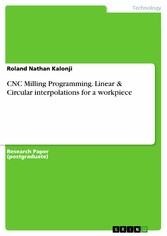CNC Milling Programming. Linear & Circular interpolations for a workpiece
von: Roland Nathan Kalonji
GRIN Verlag , 2018
ISBN: 9783668664326
, 9 Seiten
Format: PDF
Kopierschutz: frei
Preis: 5,99 EUR
eBook anfordern 
Mehr zum Inhalt

CNC Milling Programming. Linear & Circular interpolations for a workpiece
Research Paper (postgraduate) from the year 2017 in the subject Engineering - Mechanical Engineering, University of the Witwatersrand, language: English, abstract: A combined 3D linear and circular interpolation principle is developed on the basis of the 3D linear and circular interpolation principles. The task was to choose and design a creative item to be machined using CNC machining, which then required to write a code using CNC language. Prior to the machining process, we did a Computer Aided Design (CAD) drawing of the workpiece. The drawing was further modified with the final model drawn using Auto Desk Inventor. We used foam for our model and a 31 diameter end mill tool. The main problem that was experienced was the cutting time; the model took longer to be complete. The cutting time was affected by the complexity of the design, chosen tool size and the cutting technique. Besides, we learnt from the demonstration that the shorter the constructed code the more robust it is, using a bigger tool is more efficient in terms of saving energy and time, and that if the code is correct the CNC machine model becomes identical to that of the product Design.
Roland Nathan Kalonji received a BSc in Computer Science from the Université Libre (ex UPL, DRC) in 2014. He earned a PG Dip (School of Mechanical,Industrial and Aeronautical Engineering -University of the Witwatersrand,RSA,Jhb) in 2017. His first endeavours in the engineering field were "Analysis and Optimization of a Biodiesel Production from Waste Cooking Oil, Ultrasonic Monitoring System for railway tracks "etc. He received his Masters degree in 2019 (Wits-School of Mechanical,Industrial and Aeronautical Engineering ); his research interests included systems engineering and the Network Intrusion Detection Problem (NIDP).









